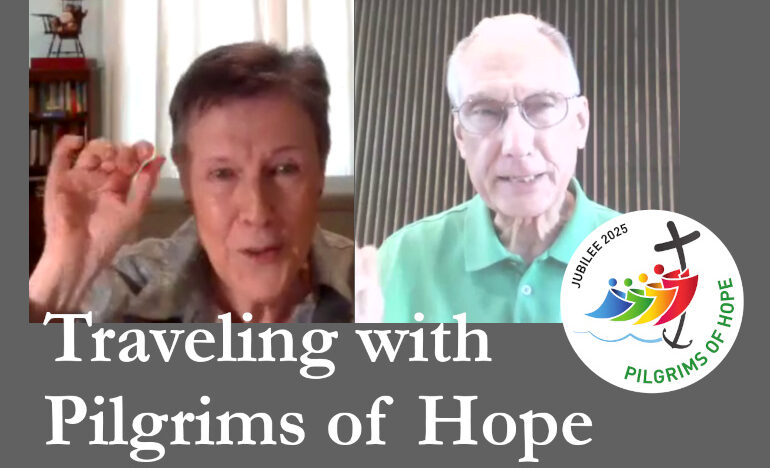Sukkot: A Joyful Celebration in the Jewish Tradition

By Kathy Keary
Our full series on Contemplative Life is here.
Our new series on Judaism and Contemplation is here.
Five days following Yom Kippur, the Jewish people celebrate Sukkot, a 3000-year-old tradition historically focused on the gathering of the autumn crops. In ancient times, Jews traveled to Jerusalem from all over to participate in the festivities which included feasting, drinking, singing, and ecstatic dancing in the streets and in the Temple. This holiday is also known as the Festival of Booths or the Feast of Tabernacles. (Falcon, 283).
Sukkot, known as the Jewish Thanksgiving, falls in proximity to the Autumnal Equinox marking the turning point toward winter. The seasonal backdrop brings to mind how our lives are deeply connected to the natural cycles found in nature. Prayers of praise and thanksgiving are offered for the bountiful harvest.
Most Jews are no longer farmers; however, the harvest analogy still holds significance as the people reflect on reaping the spiritual and emotional benefits of their experience of heartfelt repentance and forgiveness offered by the High Holy Days of Rosh Hashana and Yom Kippur.
Various rituals are associated with Sukkot; however, the liturgy is quite similar to the Shabbat service which is experienced weekly on the Jewish Sabbath. Extra prayers are said, and the entire book of Ecclesiastes is read; however, extra attendance at the synagogue is not a part of this celebration as is the case with the High Holy Days. Many honor the entire holiday at home.
Outdoor shelters known as sukkahs are constructed which call to mind the huts that Hebrews lived in during the 40 years they wandered in the wilderness after the exodus from slavery in Egypt. They also symbolize the temporary shelters people constructed to live in during the harvest inviting people to not get too attached to physical comfort (Falcon, 284).
Sukkot is a time of merriment enjoyed by children of all ages. Families often picnic in the sukkah and sometimes entertain guests in this temporary structure. Other activities that find a home in the sukkah are studying the Torah, playing music, and enjoying one another’s company (Falcon, 286).
Note: Never miss an article published on the Renewal Center website: Sign up to receive our newsletters.
Sukkot would not be complete without the presence of an etrog, a citrus fruit that looks somewhat like a lemon or the waving in various directions of a lulav: a collection of specific types of branches tied together. Rabbi Ted Falcon explains the significance of each direction:
East is the land of the rising sun, and it symbolizes new possibilities, beginnings, and awakenings.
North is the direction of clarity, rationality, and the coolness of intellect.
West is the land of the setting sun and journeys completed.
South is the direction of warmth, emotion, verdant growth, and sensual energy.
Up is the land of dreams and visions, the land of spirituality.
Down is the connection to the earth, and recognition of people’s environmental responsibilities (Falcon, 288, 289).
The day after Sukkot is called Sh’mini Atzeret when the attention shifts from the lively festivities of the prior week to a more serious focus on the forthcoming winter months. On this day, Jews pray for an abundant rain to bring in winter with the hope that the moisture will enhance the production of crops, so the people will be fed.
The following day, a day of great joy, is known as Simkhat Torah, translated as “Rejoicing in the Torah.” Often congregations will complete the yearly cycle of readings by proclaiming the end of Deuteronomy. Then the next year’s cycle is immediately ushered in with the reading of the beginning of Genesis. The Torah ends with the death of Moses. Genesis opens with the creation of the universe. By reading these passages back-to-back, the people are reminded that life transcends death and that the world is a continuous cycle of death and rebirth (Falcon, 290, 291).
Joy is expressed in a variety of ways on Simkhat Torah. Singing and dancing is commonplace as is parading around the sanctuary holding the Torah. Some synagogues unroll the entire Torah scroll placing it in a circle with children standing in the middle of the circle and the adults holding the sacred text. This allows everyone to experience a sense of shared holiness (Falcon, 291).
The themes we have uncovered are prevalent not only in Judaism but also in the major faith traditions of the world: the themes of offering praise and thanksgiving to God, the significance of the cycles found in nature, detachment, meaningful symbols and customs, the importance of family life, respect for sacred text, prayers of supplication, and a recognition that life transcends death.
Next week we will continue the exploration of the spiritual riches found in Judaism. Stay tuned.
References
Falcon, Ted and Blatner, David. Judaism for Dummies. Hoboken, New Jersey: John Wiley and Sons, Inc, 2019.
Photo 56093754 © Denisgo | Dreamstime.com
Kathy Keary, a Precious Blood Companion and spiritual director, holds a Master’s Degree in Theological Studies and is a graduate of the Atchison Benedictines Sophia Center’s Souljourners Program, an intense study of spirituality and spiritual direction. Kathy believes that the Divine is present and active in all of life and encourages others to be awakened to the God in all including the divine within. She enjoys accompanying others on their journey to wholeness discovering the person they were created to be.
We’d Like to Hear from You!
We’d like to know what you think about this article. Send us a comment using the form below. Do you have a suggestion? Is there something you want to learn more about? Send us a note.
Related

Take Nothing for the Journey
An Assembling God’s Puzzle video
By Fr. Garry Richmeier, C.PP.S.
Jesus’ teaching about what to take on a journey — nothing — is actually good advice for building trusting relationships. Don’t bring your “stuff” into the relationship; listen deeply and respec their views and situation, understand their struggles.

Pilgrims of Hope, Episode 6: Walking with Cancer Survivors
Hosted by Fr. Ron Will, C.PP.S.
We are talking with people who find hope amid difficult circumstances or bring hope to others. In this episode, Kathy Keary talks about how centering prayer, journaling and other spiritual practices helped her cope with two life threatening health issues.
Categories
Assembling God's Puzzle Coffee with Padre Cooking & Spirituality Encounters of the 4th Kind Family Matters Reflections on the Eucharsitic Prayers Spiritual Resources Taize Prayers The Contemplative Life Traveling with Pilgrims of Hope Uncategorized Videos Week of Prayer for Uhristian Unity When you need a little help
